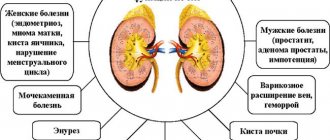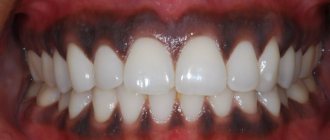| Treatment of pain in the upper abdomen of various types is carried out by the following specialists who provide consultations in our centers: gastroenterologist, cardiologist, infectious disease specialist, neurologist (neurologist), therapist. Call the unified help desk number for all our centers +7 (861) 231-1-231 and indicate which specialist you would like to make an appointment with, after which you will be connected to the selected center. Administrators will select a convenient day and time for you to visit the doctor. |
Pain in the upper abdomen is often observed with such common diseases of the gastrointestinal tract as gastritis, stomach cramps and gallbladder dysfunction.
Sometimes pain is accompanied by other symptoms, such as nausea, vomiting, diarrhea, etc. Abdominal pain can sometimes be caused by overeating. In addition, certain foods, an abundance of fat, increased gas formation, lactose intolerance when consuming dairy products - all this can provoke pain, which, as a rule, will be temporary and will go away after a few hours.
With pneumonia of the right lung, abdominal pain often occurs, while the diseased organ is located outside it.
Pain around the navel may be associated with an intestinal disorder or inflammation of the appendix.
Pain just above the belly button is usually associated with stomach problems. Among the culprits of this pain will be gastritis, stomach ulcers, and increased stomach acidity. Persistent pain in this area indicates problems with the duodenum, pancreas and gall bladder.
Pain in the left upper abdomen indicates problems with the colon, stomach and pancreas.
Pain in the upper right side , especially severe, indicates inflammation of the gallbladder. This pain may extend to the central part of the abdomen and may also radiate to the back. Other causes of such pain are pancreatitis and duodenal disorders.
Abdominal pain can also occur with diseases of the lungs and heart.
Briefly about the anatomy of the epigastrium
Organs of the Epigastrium
The upper part of the abdomen, located just above the navel, is called the epigastrium in medical literature (from the Greek words “epi” - “above” and “gaster” - “belly”). From above this area is limited by the costal arches and the xiphoid process of the sternum, and from below by a conditional line passing through the lowest points of the edges of the X ribs.
The immediate causes of pain in the upper abdomen can be both organs located in this part of the abdominal cavity, as well as nerve fibers and muscles. Most often, the stomach above the navel hurts due to pathology :
- Stomach.
- Duodenum.
- Pancreas.
- Gallbladder and bile ducts.
However, sometimes doctors have to deal with complex cases of pain in the upper abdomen, when it is not caused by pathology of the abdominal cavity.
Liver and spleen injuries
The main symptom of injuries to the spleen or liver is pain under the ribs. The location varies depending on the damaged organ, on the left side - the spleen, on the right - the liver. A distinctive symptom of damage to these organs is that the patient is unable to remain in a supine position for a long time, because the intensity of the pain increases due to the rush of blood to the diaphragm.
Damage to the liver and spleen is characterized by bleeding inside the body, due to which the patient’s skin becomes pale, the risk of loss of consciousness increases, and blood pressure quickly decreases.
Very dangerous cases occur in which a double tear of the spleen and liver occurs: first, the membrane (parenchyma) is injured, the leaked blood accumulates in the capsule, after which, with the slightest physical exertion, this capsule bursts, and the blood that was in it pours into the abdominal cavity.
Diseases of the stomach and duodenum
This is the most common cause of aching and nagging pain in the upper abdomen, as well as other complaints that make up gastric dyspepsia syndrome . This symptom complex is caused by the pathology of the stomach and duodenum and includes:
- Discomfort in the upper abdomen, which occurs both on its own and in connection with food intake.
- Nausea, sometimes vomiting of recently eaten food.
- Heaviness after eating.
- Belching is sour, bitter and rotten.
- Regurgitation, or a kind of analogue of regurgitation in adults.
- Feeling of early satiety, and many other symptoms.
These clinical manifestations, including pain in the upper abdomen, fully describe the picture of chronic gastritis - one of the most common diseases of our time. The causes of this pathology are:
- long-term errors in diet;
- frequent intestinal infections;
- hereditary predisposition;
- autoimmune processes;
- carriage of the bacterium Helicobater pylori.
The latter is the main culprit of gastric ulcer . The disease can be asymptomatic, but most often with an ulcer, patients complain of pain in the upper abdomen that occurs during or half an hour after eating.
This differs from a duodenal ulcer , in which pain occurs on an empty stomach and at night - such patients, as a rule, love to eat and they perceive food as a pain reliever.
In the absence of proper treatment, the ulcer can be complicated by extremely dangerous pathologies that require urgent surgical care:
- Perforation or perforation of an ulcer . In this case, a through hole is formed in the wall of the hollow organ, through which the entire contents of the digestive tract penetrates into the abdominal cavity and causes peritonitis. Clinically, this condition is manifested by dagger pain in the upper abdomen, sharp tension in the muscles of the abdominal wall and a rapid deterioration in general well-being.
- Penetration of an ulcer or penetration of an ulcer into nearby organs. The pancreas is most often affected and clinically this condition manifests itself in almost the same way as perforation. But the described complaints are quickly joined by symptoms of acute pancreatitis, including girdle pain in the solar plexus area.
- Bleeding from the bottom of the ulcer , which can be either minor or very pronounced. This complication is manifested by weakness, low blood pressure, bloody vomiting or melena (smelly, tarry stool). Paradoxically, often with the development of bleeding, stomach pain is significantly relieved.
- Stricture or the formation of a pronounced narrowing of the stomach as a result of scarring of the ulcer. Clinically, this is manifested by faster satiety, vomiting of recently eaten food, pain above the navel and rapid weight loss.
The most serious reason why the upper abdomen may hurt is stomach cancer . Unfortunately, externally it often looks like an ulcer, including clinically, and final diagnosis is possible only on the basis of gastroscopy with biopsy.
If a middle-aged or older person experiences symptoms of a peptic ulcer, a prolonged increase in temperature (up to 37-37.9 degrees), loss of appetite and weight loss. Then he definitely needs to be examined for cancer.
What to do?
Self-treatment of pain in the upper abdomen is unacceptable.
It is very important to visit your doctor and immediately undergo a full diagnosis in order to determine the cause of the symptoms. Having found out why the abdominal cavity hurts, you can move on to treatment. If your stomach hurts, before visiting a doctor or the arrival of an ambulance, you should take:
- antispasmodic;
- antacids (in cases where heartburn is a concern along with painful sensations);
- an antisecretory medication that slows down the process of acid production.
It is worth remembering that self-prescribing medications is dangerous. The influence of the components of the drug can distort the symptoms, which creates difficulties in diagnosis.
In addition, antispasmodics can relieve pain for a long time and create the effect of false recovery. In this case, time will be lost, which will negatively affect your health.
If you have pain in the upper abdominal region, you should never apply anything warm to your stomach. In case of purulent inflammation or bleeding, heat will only accelerate the development of pathology and worsen the patient’s well-being.
To assist the doctor in making a diagnosis, it is important to accurately tell him at the appointment about the circumstances of the onset of symptoms, the nature of the spasms and the duration of the discomfort. It is important to provide information about the movement of the source of pain, diet before the onset of spasms, and a list of medications that were taken the day before.
In some cases, spasm may extend to the side and back area
The attending physician will also be interested in the presence of vomiting, attacks of nausea, bitterness in the mouth, rashes on the skin, fever, rapid heartbeat, dizziness, muscle and joint pain on the right or left side of the back, pregnancy, lactation and menopause.
It is important to report illnesses or nervous shocks suffered in recent months.
By assisting the doctor in making a diagnosis and undergoing a complete diagnosis, it is possible to establish the exact cause that caused severe pain in the abdominal cavity. By following all the doctor’s instructions, you can cope with the disease and restore your health.
Pathology of the pancreas
Another common cause of discomfort in the epigastric region is acute and chronic diseases of the pancreas. Three pathologies are of greatest importance here.
Acute pancreatitis , or an acute inflammatory process in the tissue of the pancreas, is accompanied by sharp, often girdling abdominal pain in the solar plexus area, repeated vomiting and a rapid deterioration in general condition. The causes of this disease are:
- Alcohol abuse and improper use of alcoholic beverages (for example, combining lard or other very fatty foods with vodka).
- Addiction to energy drinks and alcoholic cocktails.
- Taking certain medications (such as anticonvulsants for epilepsy and emotional disorders).
- Gallstone disease and some other conditions.
If acute pancreatitis develops, the patient should be immediately hospitalized in a surgical hospital to prevent the development of pancreatic necrosis or complete necrosis of the organ.
Dull aching pain in the upper abdomen, especially if it is accompanied by weight loss and frequent loose stools, may indicate chronic pancreatitis .
With this disease, the function of the organ is reduced to one degree or another, and first of all, the process of breaking down dietary fats is disrupted. They are excreted unchanged from the body and lead to steatorrhea - loose, foul-smelling stool, in which feces are poorly flushed from the walls of the toilet.
A very serious cause of pain in the upper abdomen is pancreatic cancer . This disease is extremely difficult because the tumor mechanically compresses the common bile duct. In patients with pancreatic cancer, the digestive processes are severely disrupted, jaundice with lightening of the stool and typical symptoms of a malignant process are observed.
Intestinal obstruction
Bloating may be a sign that there is a blockage in the intestines that is preventing food from moving through.
Characteristic symptoms of intestinal obstruction are local pain, vomiting, delayed passage of feces, and vomiting.
Severe pain that is cramping in nature forces the patient to take various positions in which the attack is more easily tolerated.
If an obstruction has formed in the small intestine, frequent vomiting does not bring relief. First, food debris can be seen in the vomit, then bile.
Experts identify the following causes of intestinal obstruction:
- accumulation of parasites as a result of helminthic infestation;
- intestinal spasm as a result of trauma to the soft tissues of the abdomen;
- entry of a foreign body into the digestive organs;
- acute forms of chronic pathologies of the gallbladder, stomach, kidneys, etc.;
- progressive oncological diseases of the digestive tract.
Therapy is prescribed depending on the results of laboratory and instrumental studies and the identified source of pathology.
It is important to remember that if you suspect intestinal obstruction, self-medication is prohibited!
You cannot take laxatives, give enemas or administer painkillers. In a situation where bloating is accompanied by profuse vomiting and abdominal pain, you must call an ambulance.
Treatment is carried out in a hospital setting. The patient undergoes intestinal decompression and is prescribed antispasmodics or novocaine blockade.
After relief of the acute condition, the question of surgical intervention may be raised.
Diseases of the biliary tract
In some patients, diseases of the gallbladder and biliary tract may be accompanied by acute and prolonged pain in the abdomen above the navel. Although these diseases are more characterized by the localization of pain in the left hypochondrium.
Most often, the upper abdomen hurts due to cholelithiasis , a disease characterized by the formation of hard stones in the lumen of the gallbladder and bile ducts.
When one of them begins to pass through the ducts, it mechanically injures their wall and causes excruciating and unbearable pain, which is called biliary or hepatic colic . The pain syndrome can be localized both in the left hypochondrium and in the upper abdomen under the ribs, and if it appears, you should immediately consult a doctor.
Acute pain
Acute spasms often require immediate surgical intervention. That is why you should not delay calling an ambulance. As a rule, the development of a dangerous complication or damage to an internal organ is accompanied by acute pain, the inability to breathe air normally, and an attack of nausea and vomiting.
Without receiving timely medical care, a person may die. When the body is literally stabbed with a knife, it is important to immediately dial the ambulance number, and not drink painkillers and expect improvement.
It is very important to pay attention to the nature of the pain
Also, acute cramps in the upper abdomen can occur against the background of:
- ulcers;
- subphrenic abscess;
- inflammation of the pancreas of acute or chronic forms;
- myocardial infarction;
- pneumonia;
- hepatic colic;
- pleurisy;
- acute appendicitis;
- closed liver injuries;
- exacerbation of chronic disease of the gastrointestinal tract (gastrointestinal tract);
- oncology;
- splenic rupture;
- liver cirrhosis, hepatitis, pathological enlargement of the liver.
Rare causes of upper abdominal pain
It is not always possible to establish the reason why a particular patient has pain in the upper abdomen. Often patients do not understand why they undergo “extra” tests, such as ECG, chest x-ray and detailed urine tests. However, there are reasonable reasons for everything:
- In older people, acute pain above the navel may be the first signal of a myocardial infarction . Especially if there is a sharp decrease in blood pressure and sweating. Most often, this situation occurs in patients suffering from diabetes mellitus, since the functioning of the autonomic nervous system is disrupted due to impaired glucose metabolism.
- Sometimes pain in the upper abdomen is associated with pleurisy or acute inflammation of the pleura - the membrane surrounding the lungs. This is a complication of severe pneumonia, although there may be other reasons for the development of pleurisy.
- In difficult cases, when the patient, in addition to cramping pain in the upper abdomen, experiences severe watery diarrhea, attacks of suffocation, a feeling of flushing in the face and trembling of the hands, one can suspect carcinoid syndrome - a specific set of symptoms that occurs when there is a malignant neuroendocrine tumor in the body.
There are other reasons for the appearance of pain in the epigastrium, but they all require in-depth laboratory and instrumental diagnostics.
Diagnostics
If your stomach hurts in the upper middle, your family doctor knows what to do; this is the specialist you should contact if one or more of the above symptoms appears. The clinician must prescribe a laboratory and instrumental examination and refer the patient to a specialist - a cardiologist, pulmonologist, gastroenterologist or neurologist. But initially he needs to perform several manipulations on his own:
- interview the patient in detail - this will help to understand what was the source of pain, and will also indicate to the doctor the first time of appearance and intensity of expression of symptoms;
- study the medical history and life history of the patient - this will make it possible to identify some of the reasons for the formation of the main symptom;
- carry out an objective examination, including palpation of the anterior wall of the abdominal cavity, studying the condition of the skin and mucous membranes, as well as measuring temperature, pressure, counting the respiratory rate and heart rate.
Laboratory examinations include:
- general clinical blood test - to identify changes in its composition, as well as to refute or confirm the presence of anemia;
- blood biochemistry - to detect signs of an inflammatory process or the occurrence of other diseases;
- general urine analysis;
- microscopic examination of feces.
However, it is impossible to make a correct diagnosis without an instrumental examination of the patient, which includes:
- radiography - will indicate abnormalities in the structure of the spine, pleurisy, the presence of stones in the gall bladder or oncology;
- ECG – to exclude myocardial infarction;
- CT and MRI – to obtain a more accurate image of internal organs, which will help determine the diagnosis and treatment tactics;
- Ultrasound of the abdominal organs;
- endoscopic diagnostic procedures.
Carrying out an endoscopic procedure Determining the cause of pain begins with a palpation examination of the abdomen in order to detect inflammatory processes or edema. The procedure is done by lightly pressing on various parts of the abdomen. To obtain the full amount of information, it is required that the patient correctly describe the intensity and nature of the pain, its distribution within the abdominal region.
Examinations required for diagnosis:
- Ultrasound – diagnoses a specific organ in the abdominal region.
- X-ray of the spine.
- Colonoscopy - examination is carried out in the inside of the colon and intestines.
- Endoscopy – search for abnormal formations and tumors in specific areas of the stomach or esophagus.
- General blood, urine, and stool tests for the presence of viruses, bacterial infections and parasites.
- Examination of the gastrointestinal tract using x-rays over the stomach for the presence of disorders such as ulcers, inflammation, neoplasms, etc.
- MRI.
The primary diagnostic method is palpation of various areas of the abdomen to look for areas of inflammation and swelling. Further diagnostics includes the following research methods:
- MRI, CT, ultrasound, radiography (these methods will help diagnose possible fractures, ruptures, swelling and growths);
- colonoscopy (examines the inside of the colon and intestines);
- endoscopy (pathologies are detected in certain parts of the esophagus and stomach);
- blood, urine, and stool tests (to identify possible parasitic, viral and bacterial infections).
Gastralgia
Inflammation of the stomach
Dull, or, on the contrary, sharp pain in the anterior hypochondrium of the abdominal cavity causes inflammation of the stomach with high or normal acidity. This pathology is characterized by the occurrence of painful sensations in a state of hunger, due to the fact that gastric juice irritates the inflamed gastric mucosa.
But eating does not alleviate the condition, but on the contrary, it can increase the pain, because after eating, the inflamed mucous membrane is irritated by the food taken, especially if it is hard and high in acids. Therefore, patients with gastritis are recommended to eat starch-containing soups, jelly and other dishes that envelop the walls of the stomach.
Gastritis with high acidity is also characterized by symptoms such as heartburn, unstable stools prone to constipation. Aching pain and a feeling of heaviness under the solar plexus indicate the presence of gastritis with low acidity. This condition is especially worse after eating.
One of the signs confirming this diagnosis may be belching something bitter, sour, or something eaten. Vomiting with this form of gastritis brings relief. Malabsorption leads to decreased body weight, increased sweating of the hands and feet, chronic anemia, and vitamin B12 deficiency.












